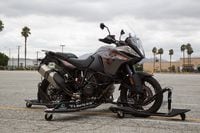Sliding around on a motorcycle will teach you a lot about the limits of traction and the dynamics of a motorcycle that is almost out of control. Problem is, as history has shown us and your Aunt Hilda constantly reminds you, sliding around on a motorcycle is very, very dangerous. From the same theory that has seen Grand Prix champions training in the dirt for decades comes the Skidbike, meant to revolutionize two-wheeled training. I was invited by our friends at KTM to a glamorous parking lot behind a Target store in San Bernardino, California, to ride and experiment with a KTM 1190 Adventure draped with Skidbike hardware.
The Skidbike kit consists, essentially, of two systems. First, the large wings that stick out either side, with the obvious intention of not letting bike or rider hit the ground. Second, the carriages that fit around both wheels. Both the wings and the carriages are fitted with casters that swivel 360 degrees, meaning if the bike was propped up on only the carriages it could move in any direction—like a (very) heavy Ikea shopping cart. As for propping the wheels up off the ground, that’s easily the coolest trick that the Skidbike does, and an integral part of what makes this system revolutionary.
A pneumatically adjustable shock is built in to each carriage, at roughly axle height, controlling the ratio of weight placed on the ground from the tire and from the casters. Basically, the Skidbike can adjust the amount of friction in each contact patch individually. The air shocks have 50mm of adjustment—via remote control, incidentally)—with 30 linear steps between maximum and minimum traction. That means the ability to have maximum traction with the rear tire but minimal traction on the front (say, for learning how ABS engages or how to handle front-end slides). Or, the more entertaining combination of lots of front grip and limited rear-wheel traction, which for a hooligan journalist who knows how to turn traction control off makes the parking lot behind Target basically a Gymkhana set.
First, though, I experimented with the standard KTM 1190 Adventure ABS and traction control software. I leaned the Skidbike over at 25-30mph and grabbed a reckless amount of front brake. The limited contact patch broke free quickly, followed instantly by quick pumps in the brake lever and the front wheel struggling for traction. The sensation of exercising the limits of traction became observable and not stressful, downright easy, because I wasn’t worried about tipping over. Because I couldn’t. Same with TC, I could spin the throttle wide open, feel the engine sputtering to accommodate the lack of traction, and not worry about screwing up. The only thing left to do, obviously, was turn all of the electronics off.
With no hydraulic pumps and software between me and the contact patch I flirted with the edge of the mechanically limited traction until the rear wheel spun on acceleration and the front wheel locked when braking. Perceiving these things from the saddle of a motorcycle is typically reserved for that brave percentage of riders who don’t mind walking on the edge of a crash, or for accidental and very brief moments that either end in a wreck or scare you halfway to hell. On the Skidbike, I stoked the fire of disaster in a way that you can only get away with if you know you can’t be burned. And it was glorious fun.
The value of a contraption like this for training is clear. Letting riders learn how to ride a motorcycle without the consequences is a damned attractive idea, especially for people who don’t know how to ride. But I think the real homerun in this idea isn’t in helping beginners avoid bumps and bruises of learning in a parking lot. It’s clear to me that the real benefit to technology like this is the ability to feel the difference between the edge of control, and a complete lack of control, without needing an ambulance standing by is an awesome idea. Unless you have the guts to lose control of a motorcycle and the skills to gather it back up, the potential for intermediate and/or self-proclaimed experts to gain confidence and understanding on the Skidbike is massive.
How much is that worth to you? Is it more or less than $23,000? That’s the going rate for this whole setup, and obviously what it’s worth to the average consumer is far from the point. This is a device that will be purchased and utilized by schools and safety organizations for the sake of expanding their curriculum. There are also options beyond the system that I tested. It’s been built for the KTM 1190 Adventure that I rode, but also Honda’s CRF250L, and a KTM 390 Duke ABS in Europe. Skidbike promotes the use of just the wings, too, which leaves out the capability of changing pressure on the contact patch but keeps the rider from crashing (arguably the best part).
You might think it’s a gimmick, and that people should learn to ride as they always have, with consequences for their actions. That’s one of the things that makes motorcycling as rewarding as it is, right? Maybe, but I’m in the camp that wants more people to enjoy motorcycles. I think the more people on the road that choose two wheels the better. Less traffic in cities, more liberated exploration in the country, and more of the satisfaction that we all feel when we swing a leg over a bike. If it gets more people enjoying life on two wheels, I hope they spread like wildfire.










/cloudfront-us-east-1.images.arcpublishing.com/octane/ANJ3ER3WUVMDXRVDKY4KBIE3WY.jpg)
/cloudfront-us-east-1.images.arcpublishing.com/octane/LB5VN25GSIOI7K6CX5XENMPISA.jpg)








/cloudfront-us-east-1.images.arcpublishing.com/octane/2WF3SCE3NFBQXLDNJM7KMXA45E.jpg)
/cloudfront-us-east-1.images.arcpublishing.com/octane/G4MG6OUCJNBSHIS2MVVOTPX65E.jpg)
/cloudfront-us-east-1.images.arcpublishing.com/octane/IIGGWFOTOJGB7DB6DGBXCCMTDY.jpg)
/cloudfront-us-east-1.images.arcpublishing.com/octane/QSTCM6AVEZA5JJBUXNIQ3DSOF4.jpg)
/cloudfront-us-east-1.images.arcpublishing.com/octane/U4I7G625B5DMLF2DVIJDFZVV6M.jpg)
/cloudfront-us-east-1.images.arcpublishing.com/octane/B6XD6LS6IVCQPIU6HXDJSM3FHY.jpg)
/cloudfront-us-east-1.images.arcpublishing.com/octane/ICL63FEDDRDTTMINYICCEYGMDA.jpg)
/cloudfront-us-east-1.images.arcpublishing.com/octane/FCGZHQXRBZFLBAPC5SDIQLVF4I.jpg)
/cloudfront-us-east-1.images.arcpublishing.com/octane/WNOB6LDOIFFHJKPSVIWDYUGOPM.jpg)

/cloudfront-us-east-1.images.arcpublishing.com/octane/X33NU3E525ECRHXLNUJN2FTRKI.jpg)
/cloudfront-us-east-1.images.arcpublishing.com/octane/6KKT5NNL2JAVBOXMZYS5ZO76YA.jpg)
/cloudfront-us-east-1.images.arcpublishing.com/octane/J5RKG5O455GMPGQRF2OG6LRT7A.jpg)
/cloudfront-us-east-1.images.arcpublishing.com/octane/GX2CIZKQVRH2TATDM26KFG2DAE.jpg)
/cloudfront-us-east-1.images.arcpublishing.com/octane/ZWIDYSAKQZHD5BHREMQILXJCGM.jpg)
/cloudfront-us-east-1.images.arcpublishing.com/octane/CYUHJZCTSJCH3MRAQEIKXK7SCQ.jpg)
/cloudfront-us-east-1.images.arcpublishing.com/octane/LKOFINY56FCXJCANJ5M7ZDQUBY.jpg)
/cloudfront-us-east-1.images.arcpublishing.com/octane/4NBPDACMWJH63JQYJVK3QRBDZI.jpg)
/cloudfront-us-east-1.images.arcpublishing.com/octane/KKHQHRR3FJGX7H2IPU6RALMWG4.jpg)

/cloudfront-us-east-1.images.arcpublishing.com/octane/5IOFS5JAE5FOXMNA23ZRAVVYUU.jpg)
/cloudfront-us-east-1.images.arcpublishing.com/octane/CGXQ3O2VVJF7PGTYR3QICTLDLM.jpg)

/cloudfront-us-east-1.images.arcpublishing.com/octane/OQVCJOABCFC5NBEF2KIGRCV3XA.jpg)